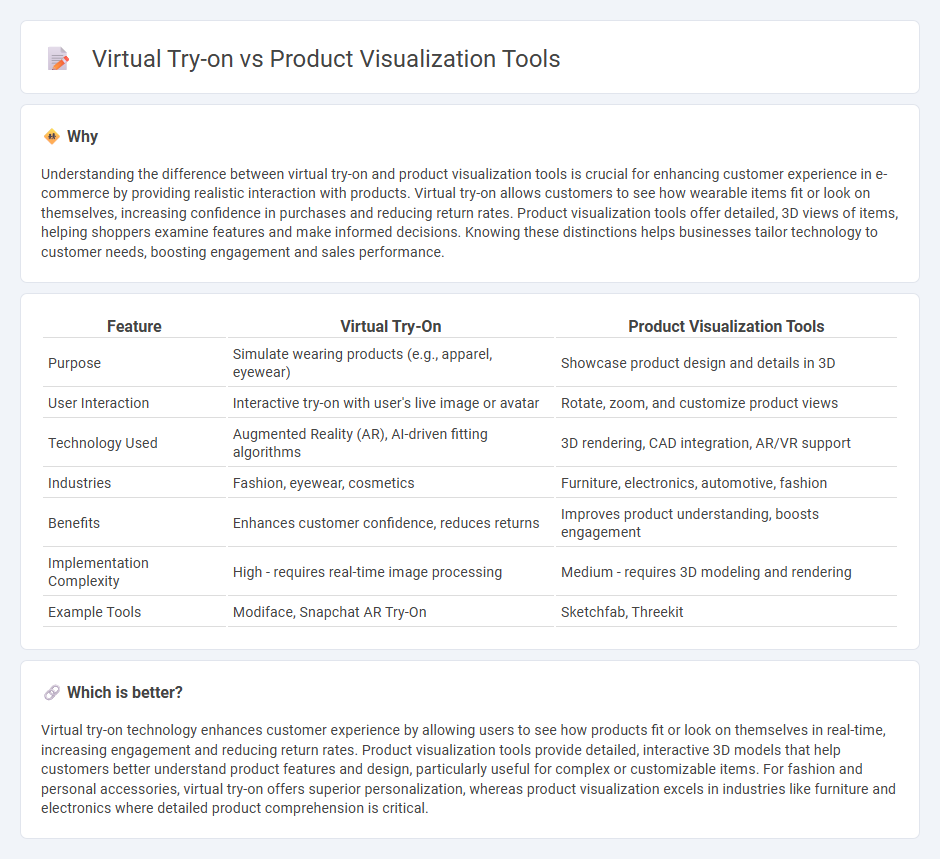
Virtual try-on technology enhances e-commerce by allowing customers to see how products like clothing, eyewear, or makeup look on them in real-time using augmented reality, increasing engagement and reducing return rates. Product visualization tools offer detailed 3D models and interactive views that let shoppers examine items from all angles, improving decision-making for categories such as electronics, furniture, and accessories. Explore the latest advancements in these tools to transform your online shopping experience and boost sales.
Why it is important
Understanding the difference between virtual try-on and product visualization tools is crucial for enhancing customer experience in e-commerce by providing realistic interaction with products. Virtual try-on allows customers to see how wearable items fit or look on themselves, increasing confidence in purchases and reducing return rates. Product visualization tools offer detailed, 3D views of items, helping shoppers examine features and make informed decisions. Knowing these distinctions helps businesses tailor technology to customer needs, boosting engagement and sales performance.
Comparison Table
| Feature | Virtual Try-On | Product Visualization Tools |
|---|---|---|
| Purpose | Simulate wearing products (e.g., apparel, eyewear) | Showcase product design and details in 3D |
| User Interaction | Interactive try-on with user's live image or avatar | Rotate, zoom, and customize product views |
| Technology Used | Augmented Reality (AR), AI-driven fitting algorithms | 3D rendering, CAD integration, AR/VR support |
| Industries | Fashion, eyewear, cosmetics | Furniture, electronics, automotive, fashion |
| Benefits | Enhances customer confidence, reduces returns | Improves product understanding, boosts engagement |
| Implementation Complexity | High - requires real-time image processing | Medium - requires 3D modeling and rendering |
| Example Tools | Modiface, Snapchat AR Try-On | Sketchfab, Threekit |
Which is better?
Virtual try-on technology enhances customer experience by allowing users to see how products fit or look on themselves in real-time, increasing engagement and reducing return rates. Product visualization tools provide detailed, interactive 3D models that help customers better understand product features and design, particularly useful for complex or customizable items. For fashion and personal accessories, virtual try-on offers superior personalization, whereas product visualization excels in industries like furniture and electronics where detailed product comprehension is critical.
Connection
Virtual try-on and product visualization tools enhance e-commerce by providing immersive and interactive experiences that allow customers to visualize products in real-time before purchase. These technologies use augmented reality (AR) and 3D modeling to simulate accurate product fit, appearance, and functionality, reducing return rates and increasing customer confidence. Integration of virtual try-on with product visualization drives higher engagement, personalization, and conversion rates in online retail.
Key Terms
3D Modeling
Product visualization tools leverage advanced 3D modeling software to create detailed and interactive representations of products, enhancing consumer understanding and engagement. Virtual try-on technology integrates 3D models with augmented reality to allow users to experience products, such as apparel or accessories, in a personalized, immersive environment. Explore how cutting-edge 3D modeling drives both tools to revolutionize online shopping experiences.
Augmented Reality (AR)
Augmented Reality (AR) enhances product visualization tools by creating interactive 3D models that allow customers to examine products in real time, improving decision-making and reducing returns. Virtual try-on solutions leverage AR to simulate the appearance of apparel, accessories, or makeup on users, offering a personalized shopping experience that boosts engagement and brand loyalty. Discover how AR-driven product visualization and virtual try-on technologies are transforming retail experiences.
Fit Simulation
Product visualization tools create detailed 3D models to showcase item appearance and texture, while virtual try-on solutions emphasize fit simulation by mapping the product onto the user's body for accurate size and shape representation. Fit simulation leverages advanced technologies such as augmented reality (AR) and artificial intelligence (AI) to adapt clothing to individual body measurements and movements. Discover how these innovations improve customer satisfaction and reduce return rates by exploring the latest advancements in fit simulation technology.
Source and External Links
Product visualization software for ecommerce - Kickflip - Kickflip offers a virtual product configurator with features like unlimited variant options, real-time rendering, dynamic pricing, and integration with major ecommerce platforms such as Shopify and WooCommerce, enabling customers to customize, visualize, and dynamically price products online.
Top 3D Product Visualization Software in 2025 - Slashdot - This resource presents a comprehensive comparison of leading 3D product visualization tools like 3D Cloud, rooom AG, Augment, and Threekit, which allow creation of realistic digital models for product design, marketing, and sales without the need for physical prototypes.
Cylindo - 3D Furniture Product Visualization Platform - Cylindo specializes in 3D product visualization for furniture ecommerce, providing automated creation and management of photorealistic 3D assets and immersive digital merchandising solutions that increase conversion rates and customer confidence.
 dowidth.com
dowidth.com